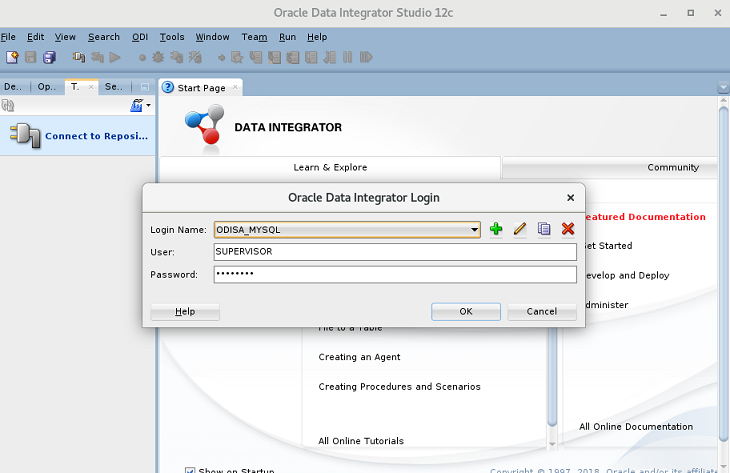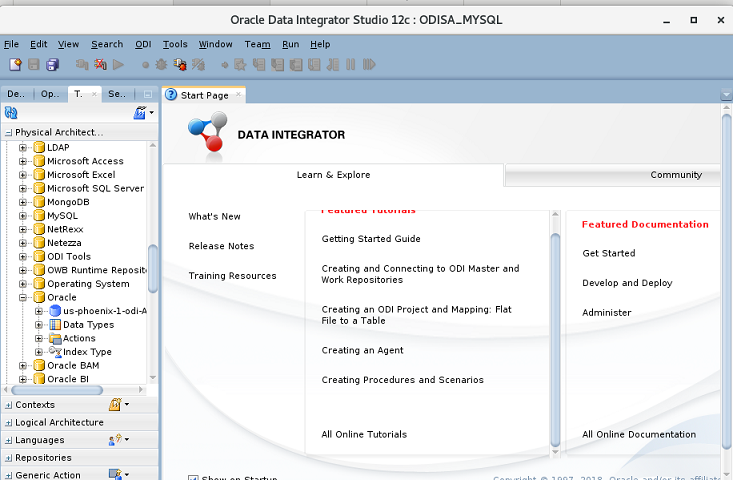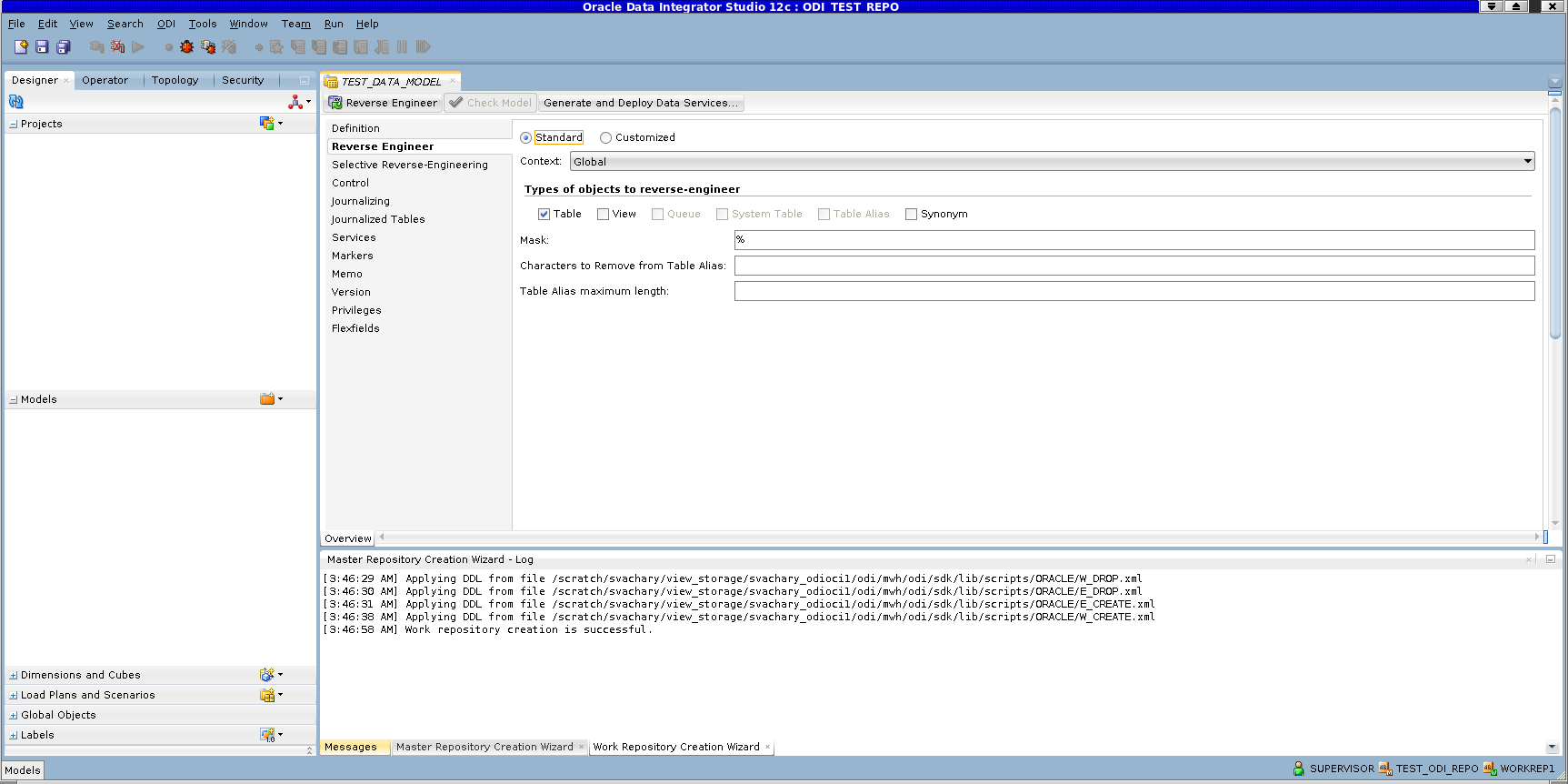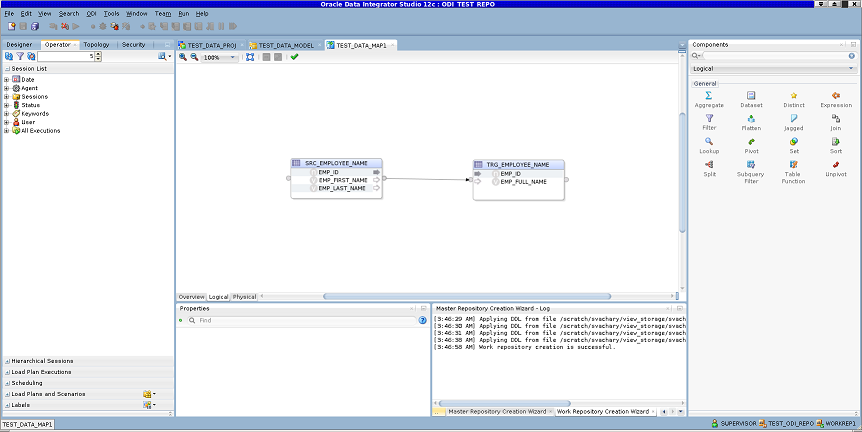2 Working with ODI Instance
This chapter guides you to connect and work with the ODI instance.
It contains the following sections:
Connecting to ODI Instance
You can connect to an ODI instance by using a Secure Shell (SSH) connection. Most Linux distributions include an SSH client by default. For Windows, you can download a free SSH client called PuTTY from http://www.putty.org.
Note:
When you’re logged in as the default user - opc, you can use the sudo command to run administrative tasks.-
To connect to your ODI instance from linux,
- Log in to your instance using SSH.
- Use the following command to set the file permissions so that only you can read the file:
where$ chmod 400 <private_key><private_key>is the full path and name of the file that contains the private key associated with the instance you want to access. - Use the following SSH command to access the instance.
where$ ssh –i <private_key> <username>@<public-ip-address><private_key>is the full path and name of the file that contains the private key associated with the instance you want to access.<username>is the default name for the instance. The default user name isopc.<public-ip-address>is your instance IP address that you retrieved from the Console.
-
To connect to your ODI instance from windows,
- Open putty.exe.
- In the Category pane, select Window, and then select Translation.
- In the Remote character set drop-down list, select UTF-8. The default locale setting on Linux-based instances is UTF-8, and this configures PuTTY to use the same locale.
- In the Category pane, select Session and enter the following:
- Host Name (or IP address):
<username>@<public-ip-address>, where<username>is the default name for the instance. For Oracle Linux and CentOS images, the default user name is opc. For the Ubuntu image, the default name is ubuntu and<public-ip-address>is your instance public IP address that you retrieved from the console. - Port: 22
- Connection type: SSH
- Host Name (or IP address):
- In the Category pane, expand Connection, expand SSH, and then click Auth.
- Click Browse, and then select your private key.
- Click Open to start the session.
If this is your first time connecting to the instance, you might see a message that the server's host key is not cached in the registry. Click Yes to continue the connection.
Starting ODI Studio
- Install a VNC viewer on your local computer.
- Use SSH to connect to the compute instance running the Oracle Data Integrator Image, as described in Connecting to ODI Instance.
- Configure a VNC password by typing
vncpasswd. - When prompted, enter a new password (for example - welcome1) and verify it.
- Optionally, enter a view only password.
- After the
vncpasswdutility exits, start the VNC server by typingvncserver, for examplevncserver -geometry 1920x1000.This will start a VNC server with display number 1 for the opc user, and the VNC server starts automatically if your instance is rebooted.
- On your local computer, connect to your instance and create a ssh tunnel for port
5901 (for display number 1):
$ ssh -L 5901:localhost:5901 –i id_rsa opc@<IP Address>. - On your local computer, start a VNC viewer and establish a VNC connection to
localhost:1. - Enter the VNC password that you had set earlier.
To launch the ODI instance,
- From the Applications menu, navigate to Accessories → ODI Studio
or
Navigate to the location/home/opc/oracle/odi/studio/bin/odiin the VNC. -
Connect to the repository with the already populated login credentials.

Description of the illustration launch_odistudio.pngNote:
While connecting to your repository, if you had closed your MySQL instance by mistake,use the following commands to restart it:
sudo systemctl stop mysqlodi.service sudo systemctl start mysqlodi.serviceUse the following command to get the MySQL user password
This command helps you to get the default password for all MySQL users/home/opc/oracle/odi/common/scripts/getPassword.sh(root/DEV_ODI_REPO).Note:
Do not change the default password for DEV_ODI_REPO user. -
Navigate to the ODI web app and configure the ADWC Dataserver setup. You can access the ODI web app using the URL
http://<IPADDRESS>:8080/odi. Use the following commands to start and stop the ODI web app:sudo systemctl stop jettyodi.service sudo systemctl start jettyodi.service -
Post successful configuration, check if the newly created data server is available in the Topology navigator -> Technologies -> Oracle

Description of the illustration data-server.png -
In the ODI studio, check if the Oracle Standalone Agent is working. Use the following commands to stop and start the standalone agent:
sudo systemctl stop agentodi.service sudo systemctl start agentodi.serviceUse the following command to know the status of the standalone agent:
sudo systemctl status agentodi.serviceUse the following command to view the logs:
sudo journalctl -u agentodi.service -f -
Depending on your network, you may need to provide proxy details for the database server JDBC connection.

Description of the illustration jdbc_connection_url.png -
Click Test connection, to check if the created ADW Dataserver is working.
-
Depending on your network, you can setup a proxy for ODI. In ODI Studio, navigate to Tools, Preferences, Web Browser and Proxy, to setup a proxy for your network. Proxy may be required for accessing certain hosts, for example - Oracle Object Storage.
For executing mappings and packages with the standalone agent:- Use the following command to stop the agent:
sudo systemctl stop agentodi.service - From the ODI OCI instance, navigate to the location
/home/opc/oracle/odi/common/scriptsand edit the filestartAgent.pyand add the following lines after the propertyafter -Drepo.props=-Dhttp.proxyHost=www-proxy-xxx.com -Dhttp.proxyPort=80 -Dhttps.proxyHost=www-proxy-xxx.com -Dhttps.proxyPort=80 -cpFor example, after adding the above lines, your file should be like this:
subprocess.call('nohup java -Drepo.props=odi-standalone-studio.properties -Dhttp.proxyHost=www-proxy-xxx.com -Dhttp.proxyPort=80 -Dhttps.proxyHost=www-proxy-xxx.com -Dhttps.proxyPort=80 -cp $AGENTCLASSPATH oracle.odi.OdiStandaloneAgentStarter'+' '+oraclediagentPath+" &", shell=True) - Save the file and use the following command to start the agent:
sudo systemctl start agentodi.service - Test the standalone agent from ODI studio to see if the agent has started successfully. Then run the mapping using the standalone agent.
Note:
Ensure you do not add any extra lines or space or tab on this file. Just add -D option within the line content. It is a python script and it requires proper line indentation to work.
Note:
If you are using a BI Cloud Connector Dataserver, you may need to add the BI Cloud Connector host to the Proxy Exclusion field. - Use the following command to stop the agent:
Configuring Data Sources and Targets
The physical components that store and expose structured data in Oracle Data Integrator (ODI) are defined as data servers. Each data server is always linked to a single technology. It stores information according to a specific technical logic, which is declared in the physical schemas attached to it.
For example -

Description of the illustration topology.png
For more information, refer to Overview of Oracle Data Integrator Topology chapter in Developing Integration Projects with Oracle Data Integrator guide.
Reverse Engineering Data Models
To automatically populate datastores into the model, you reverse-engineer the model. A standard reverse-engineering uses the capacities of the JDBC driver used to connect the data server to retrieve the model metadata. A customized reverse-engineering uses a reverse-engineering Knowledge Module (RKM), to retrieve metadata for a specific type of technology and create the corresponding datastore definition in the data model.
For example -

Description of the illustration reverse-engineer.png
For more information, refer to Creating and Reverse-Engineering a Model chapter in Developing Integration Projects with Oracle Data Integrator guide.
Creating Mappings
Mappings in Oracle Data Integrator (ODI) are the logical and physical organization of your data sources, targets, and the transformations through which the data flows from source to target. Mappings are made up of several parts, datastores, datasets, re-usable mappings, connectors, knowledge modules, variables, sequences, user functions, and other components. Optionally, you can specify a staging schema. You create and manage mappings using the mapping editor, which opens whenever you open a mapping. Mappings are organized in folders under individual projects, found under Projects in the Designer Navigator.
For example -

Description of the illustration mappings.png
For more information, refer to Creating and Using Mappings in Developing Integration Projects with Oracle Data Integrator guide.
Monitoring ODI Executions
Monitoring your development executions consists of viewing the execution results and managing the development executions when the executions are successful or in error. Through Operator Navigator, you can view your execution results and manage your development executions in the sessions, as well as the Scenarios and Load Plans in production. Operator navigator stores this information in a work repository, while using the topology defined in the master repository.
For example -

Description of the illustration monitoring-odi.png
For more information, refer to Monitoring Integration Processes chapter in Administering Oracle Data Integrator guide.
Installation Locations
Please note, the following installation locations are used by this image. You may need this information if you want to change any aspects of the installation:
Table 2-1 Installation Locations
| Area | Location on Server |
|---|---|
|
Oracle Home (home of the ODI installation for patching). |
/home/opc/oracle |
|
OPatch Home |
/home/opc/oracle/OPatch |
|
MySQL Home |
/home/opc/mysql_home |
Note:
To retrieve the password stored in wallet, execute the following command -/home/opc/oracle/odi/common/scripts/getPassword.sh